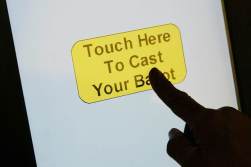Disrupt the Vote: Could tech create a new voting experience?

Imagine a day when Americans no longer need to sweat out election returns in front of their TV screens or Twitter feeds.
Tabulating votes would take only minutes — enough time for the National Security Agency to run a query on voters’ emailed ballots using a fully encrypted system. No more election night horse race coverage. No embarrassing “Dewey Defeats Truman” headlines. No more hanging chads.
The scenario may seem far-fetched, but some of these ideas were pitched by “election futurists” during a joint symposium held by the National Institute of Standards and Technology and the Election Assistance Commission. They examined the ways technology could change how Americans vote.
By all accounts, election technology is moving at a glacial pace, even by government standards. As cutting-edge technology becomes increasingly available, budgets remain low and can widely vary among municipalities. But some experts say the most crucial part of advancing election technology lies with public perception.
How to apply that cutting-edge technology is also one of the most confounding things for election officials, due to the need to make voting technology accessible to those with disabilities. Melanie Bull, the public policy director for the Tennessee Disability Coalition, said any tool, created from scratch or built on top of already-existing products, should use input from disabled communities if it wants to see broader adoption.
“One of the interesting things about technology is people with disabilities are leaders, trendsetters and can be canaries in the mine,” Bull said. “If you can make technology work for someone with disabilities, you can work with anyone.”






